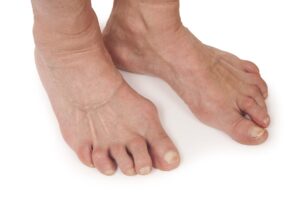
What is a Morton’s Neuroma?
Morton’s Neuroma is often termed an “interdigital” neuroma as it is problematic between the toes in the forefoot, most commonly the 3rd and 4th toes. A neuroma is a thickening or swelling of the sheath that surrounds the digital nerve. The nerve becomes entrapped and inflammation is caused by the irritation from the bony structures.
Symptoms of Morton’s Neuroma
Symptoms associated with Morton’s neuroma including pain in the ball of the foot. It can be described as a dull burning sensation that radiates into the toes. It can feel like stone under the forefoot, occasionally a sharp snap can be felt as the neuroma clicks between two bones. Other symptoms include pins and needles or potentially even numbness to particular toes.
What causes a Morton’s Neuroma?
A Morton’s Neuroma is a result of biomechanical changes that occur in your feet, predominantly in the forefoot. Constant trauma and movement from the surrounding bones damage the nerve and increase the thickness of the nerves insulating sheath. This causes aggravation and inflammation; therefore, pain in the toes.
Tight-fitting shoes may exacerbate a Morton’s Neuroma; footwear is a common cause of pain. Shoes such as high heels and shoes with tight toe boxes are particularly damaging to the forefoot.
An overloaded forefoot or a flexible, flat, wide foot can also increase the chance of a Morton’s Neuroma. If there is an imbalance in the structure of the foot, this can cause abnormal motion. The abnormal motion can then stress specific bones and tissue. Bunions, hammertoes, claw toes or a rigid cavus foot can also add pressure to the forefoot and again, be further susceptible to nerve compression in the foot.
Diagnosis
Your podiatrist will be able to help diagnose a Morton’s Neuroma. There are multiple conditions that affect the forefoot so a correct diagnosis is very important. Informed detailed history taking is an imperative part of forming a diagnosis and into an appropriate treatment plan. Important factors include, symptom history, footwear and exercise type, duration and intensity.
A hands on approach by your Podiatrist is also required when diagnosing forefoot pain. There are tests that can suggest a Morton’s neuroma; a thorough biomechanical assessment and gait analysis is also important.
Treatment of a Morton’s Neuroma
Footwear Assessment
Inappropriate or ill fitting footwear is one of the biggest causes of neuroma pain in the forefoot. Due to this, modifying or changing your footwear is one of the biggest factors in relieving pain. Avoid tight fitting shoes and high heels. Changing the laces to your current footwear can also be beneficial. Your Podiatrist can show you a variety of ways to change your laces for you.
Addressing the Foot and Lower Limb Biomechanics
Treatment may include joint mobilisation and alignment techniques, dry needling, massage, stretches/exercise program, taping and orthotics. Your podiatrist will determine just what combination of treatment modalities will be most helpful following a thorough assessment.
Improving your foot posture is important when treating pain. Altering biomechanics and loading patterns will help to change damaging forces through your feet. Any tissue stress or nerve irritation from bony structures can be eased or relieved using various conservative treatment options. Orthotics with specific neuroma modifications are often prescribed to do this. Orthotics can help in two ways – the help to stabilise the forefoot when hypermobile and they also help to prevent the metatarsal bones in the forefoot from irritating or squeezing the nerve. This helps reduce symptoms associated with Morton’s Neuroma.
When to see your Podiatrist
If you are experiencing forefoot pain or are worried that you may have a Morton’s neuroma come and visit us in the clinic and we will take you through a thorough assessment, help with making a diagnosis and discuss the treatment plan with you.
Thanks for reading, and have a wonderful day!
Share this post:
Recent Posts

Hip Dysplasia: A Guide for Parents and Adults
Hip dysplasia (developmental dysplasia of the hip – DDH) is a condition that affects the hip joint.

Heel Spurs: Understanding the Cause and Finding Relief
Heel pain can be a real drag, especially when that first step in the morning feels like stepping on a tack. One culprit behind this discomfort can be heel spurs. But what exactly are they, and more importantly, how can you fix them?

Conquering Foot Pain: Effective Strategies for Arthritic Feet
Arthritis in the feet can significantly disrupt your daily life, turning simple walks into painful struggles.

Blisters Be Gone: How to Keep Your Feet Happy on Every Run
Blisters – the bane of a runner’s existence. Those pesky little pockets of fluid can turn a joyful run into a painful slog. But fear not, fellow runner!


